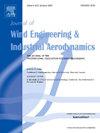Optimizing cycling skinsuit design through an integrated wind-tunnel and CFD workflow
IF 4.9
2区 工程技术
Q1 ENGINEERING, CIVIL
Journal of Wind Engineering and Industrial Aerodynamics
Pub Date : 2025-07-04
DOI:10.1016/j.jweia.2025.106154
引用次数: 0
Abstract
This paper explores the use of computational fluid dynamics (CFD) in the design of cycling skinsuits with varying surface roughness. Traditional skinsuit design involves a complex and time-consuming process by wind tunnel experiments. CFD could potentially offer an alternative for predicting the performance and designing rider-specific skinsuits, though accurately modelling fabric surface roughness is challenging. The study characterizes skinsuit fabrics based on an equivalent sand-grain roughness height (kS) value derived from drag reduction measurements on cylinders covered with specific fabrics. Three skinsuits, created from these fabrics, are assessed on a full-scale cyclist mannequin. For two of the three suits, the calculated drag area is within 0.6 % of the wind tunnel (WT) results. In the case of the third suit, the deviation with the WT drag area is 1.6 %. The CFD simulations reveal valuable insights, such as the impact of including variable kS values on the location of flow separation, the local distribution of skin friction and pressure drag, and their effects on the near flow field. The agreement between WT and CFD results suggests the potential of CFD for designing aerodynamically optimized skinsuits for individual riders, while further research is recommended to refine and validate this approach.
通过集成风洞和CFD工作流程优化自行车皮衣设计
本文探讨了计算流体力学(CFD)在不同表面粗糙度骑行服设计中的应用。传统的服装设计是一个复杂而耗时的风洞实验过程。尽管准确模拟织物表面粗糙度具有挑战性,但CFD可能为预测性能和设计骑手专用的皮衣提供另一种选择。该研究基于等效沙粒粗糙度高度(kS)值,该值来自覆盖特定织物的圆柱体上的阻力减少测量。用这些面料制作的三套皮衣,在一个全尺寸的自行车人体模型上进行了评估。对于三种服装中的两种,计算的阻力面积在风洞(WT)结果的0.6%以内。在第三套情况下,与WT阻力面积的偏差为1.6%。CFD模拟揭示了一些有价值的见解,例如加入可变k值对流动分离位置的影响、表面摩擦和压力阻力的局部分布以及它们对近流场的影响。WT和CFD结果之间的一致性表明,CFD在为个人车手设计空气动力学优化的服装方面具有潜力,但建议进一步研究以完善和验证这种方法。
本文章由计算机程序翻译,如有差异,请以英文原文为准。
求助全文
约1分钟内获得全文
求助全文
来源期刊
CiteScore
8.90
自引率
22.90%
发文量
306
审稿时长
4.4 months
期刊介绍:
The objective of the journal is to provide a means for the publication and interchange of information, on an international basis, on all those aspects of wind engineering that are included in the activities of the International Association for Wind Engineering http://www.iawe.org/. These are: social and economic impact of wind effects; wind characteristics and structure, local wind environments, wind loads and structural response, diffusion, pollutant dispersion and matter transport, wind effects on building heat loss and ventilation, wind effects on transport systems, aerodynamic aspects of wind energy generation, and codification of wind effects.
Papers on these subjects describing full-scale measurements, wind-tunnel simulation studies, computational or theoretical methods are published, as well as papers dealing with the development of techniques and apparatus for wind engineering experiments.

 求助内容:
求助内容: 应助结果提醒方式:
应助结果提醒方式:


